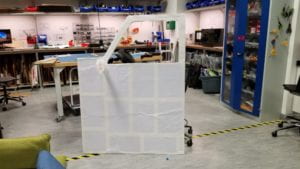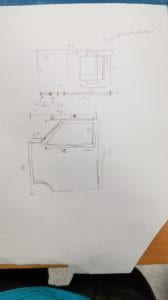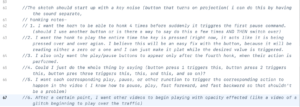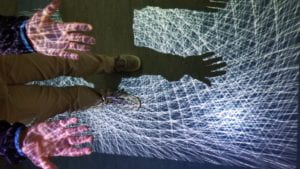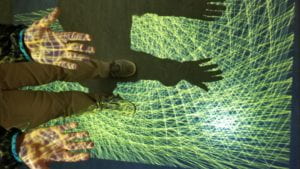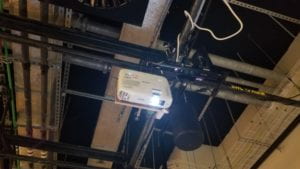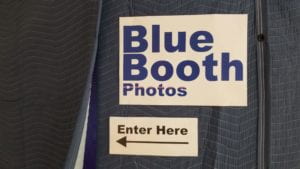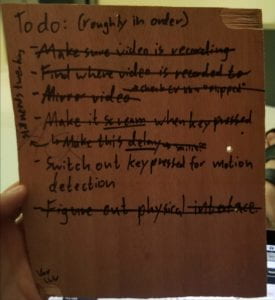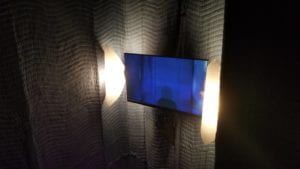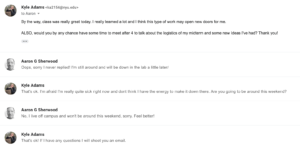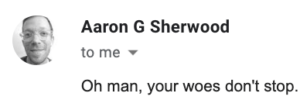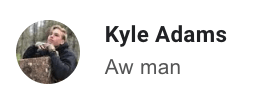Introduction:
My goal for this project was not to get all fancy with gadgets and gizmos and things that I barely knew how to use, but to use the skills I had acquired during this class and before in order to tell a complete, consistent, and compelling story that was both visually and auditorially engaging.
In order to do this I combined some of the skills in video and timeline creating in openFrameworks from my mid term with pretty much the most interesting/ fun thing I had learned in Interactive media since: projection mapping. I have had a longtime fascination with video making, and I feel like projection mapping is one of the most exciting ways to incorporate it into interactive media. Although my projection map ended up only being a small car without any moving parts, I feel like the way it integrated me into my performance was clever and wonderful.
Description:
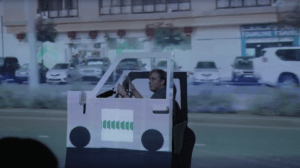
My projection mapped performance Time Machine is the story of a man stuck in traffic who suddenly realizes that his car had turned into a time Machine. He plays around with the play and pause feature, controlled by the horn of his car until he realizes that he can pause time all he wants, but that will not get him to work faster. He sleuths around to see whether anything else in his car can control time. After some searching, he finds that his turn signal can make the car go forward or backward depending on which way it is pressed. He plays with this feature too until he realizes that going backwards and forwards won’t get him to work fast either, at which point, he cranks the speed up to maximum. At this point, something happens, either a crash or a glitch, and everything stops and is drenched in red. He fiddles around for a moment until the machine starts going back uncontrollably. The video gets faster and faster. Images of the industrial revolution and dinosaurs flash by in an instant as everything begins to fall apart. A circular glitch signifies the ending and looping of time. Finally, it disappears, and all that is left is the video signal for “stop” a small square, drenched in red. He reaches out the door and presses it and everything ends.
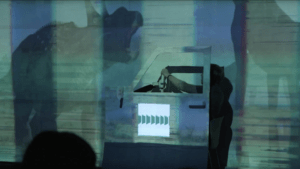
Now picture that story if it was a little bit funny and that is basically how my performance was.
In order to help signify what was happening in the story, besides the audio and visual cues of the projection behind me, I had a button mapped on to the door of the car that would change between pause, play, fast forward, fast backward, and stop.
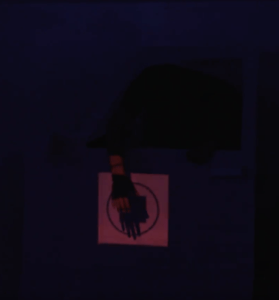
Process:
In the end, the performance ended up consisting of several layers of video and audio cues triggered by buttons. In order to make the interaction with the car convincing, I incorporated these buttons into it. I started out planning to have separate projections for the background and the car, but ended up incorporating them into one single projection. In the end, I believe this was not only easier, but much more cohesive.
To get the video, I actually took a couple of trips into the city in good filming light. I used my phone to take video from inside taxis whenever we were in a traffic-ridden zone. I used one of the videos I liked the best.
As far as the soundscape, I combined and sampled sounds from the NYU stock sound folder. An example of this is the key jingling and car starting sound at the beginning of the performance. I looked through hundreds of clips for just the right audio. I could not find exactly what I wanted, so I spliced multiple clips together.
Building the car was problematic due to lack of suitable resources. In order to make it white I had to use white paper and tape, as there was no white material to make it out of, or white paint to paint it. Also, because I made it out of cardboard, it was not very structurally sound, even after I supported it with scrap acrylic.
After my code was mostly complete, I spent several hours setting up my projection map and figuring out the perfect way to make it so that I could move the car in and out of the performance space. I had the car attached to a small trolley table. I used that to bring it to the wall. I then used the shadow of the door on the background to align the door.
Code:
(my code is in the title for code, isn’t that clever?)
My code had several parts including Serial Communication, video playing, audio playing, image mapping.
My first major struggle was figuring out how to make a linear story play with just a trigger button. In order to do this I created (with the help of some friends) a counter that counted up each time a button was pressed.
It took me some time to figure out exactly the format in which to play videos and audio in order to have them playing, how you want them playing, when you want them playing. Eventually I figured it out however, and was able to start building the code to my story.
After finishing pretty much everything, I was still having problems with one of my buttons, which kept bouncing (pressing twice in a row.) I fixed it by incorporating some debouncing code into my Arduino file, which was difficult because I had to work around my serial communication.
Reflection:
Overall, I was very pleased with how this project turned out, and have received some really helpful and positive feedback. I believe that having a strong anchor point in my storyline was really helpful in keeping me on track. I also believe that I not only had acquired new skills with this project, but also had a greater realization of my limits. I played to my strengths and was able to make a powerful product with minimal headache.
I believe that my biggest shortcoming in this performance was not my tech, but actually my acting. If I were to do this performance again, I would work with an actor other than myself, so that I could give them direction, especially since the performance is better with a little well-though-out wit. This time it was easier to work alone, as I mostly knew what I wanted, and had no time to train an actor on these things, especially as I was building it. I also believe retrospectively that I could have created a better, but did not have the time away from it after the whole performance was completed to remove myself from it and think about the aesthetic. AN example of this is making a better video set that didn’t have a long idle section, or incorporating a crash sound when everything turns red.
if anything, this project has proven that I have learned a lot in one year. In January, when I took my first IM course, I had never coded before in my life. Now I am semi-competent with the basics of a professional coding program. I’d say that’s pretty good.

